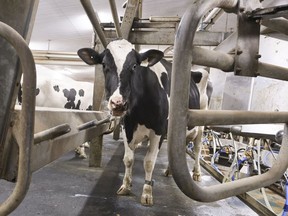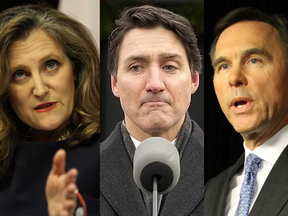Ted Rechtshaffen: No need to rely on high rates, job losses, forcing people to stop spending to make mortgage payments
Article content
Inflation is the great evil of an economy, according to the Bank of Canada. It is so important to get our inflation rate to two per cent that it will use the tool of raising interest rates significantly to get there. Yes, it may cost hundreds of thousands of people their jobs, but it will be worth it. Yes, it may cost Canadians billions of extra dollars on their mortgages, but it will be worth it. Inflation is just that insidious, so it must be tamed even if it comes at tremendous costs to large swaths of the population.
Advertisement 2
Article content
Let’s take the above argument as given. Inflation is so bad that we need to swallow our medicine to get it under control. However, if taming inflation is the goal, there are several other ways to get us there. The question is: Why are we OK with massive job loss and massive mortgage hikes, but not OK taking advantage of these five steps?
Article content
Step No. 1: Lower mortgage interest costs
The consumer price index was 3.4 per cent in December. As a component of CPI, mortgage interest costs were up 28.5 per cent year over year. Without the mortgage interest cost increase, the CPI over the second half of 2023 would have been in the two per cent to 2.5 per cent range.
The simple solution here is to lower mortgage costs and you will lower inflation. How do you lower mortgage costs? In large part, you lower the Bank of Canada overnight interest rate.
I understand that moving one dial can impact other prices, but it is pretty hard to ignore a component of the CPI that went up 28.5 per cent as the biggest nail that needs to be hammered back into place. It also happens to be the one inflation component the Bank of Canada has more control of than any other.
Article content
Advertisement 3
Article content
Step No. 2: Reduce the price of milk
Canada has the world’s fifth-most-expensive milk at US$2.14 a litre, according to research on 97 countries by Numbeo. The United States was No. 72 at US$1.06 a litre. Canadian milk costs double that of the U.S. A few other countries of note: France: US$1.20; Germany: US$1.18; and Spain: US$1.13.
Canadians should be up in arms about this.
Among the four countries with more expensive milk than Canada are Hong Kong and Singapore, both city states with minimal, if any, rural areas.
The gap in the price of milk between Canada and the U.S. simply doesn’t exist among other core food categories. What could possibly explain the difference in milk prices? Could it be the government-mandated milk marketing boards, pricing and tariffs? Of course it could.
You can argue all you want that this is a good thing for Canadians (or at least Canadian dairy farmers), but if inflation is so bad, and milk is so much more expensive here, then let’s attack that inflationary problem.
Either do away with the entire milk marketing system, or significantly water it down by allowing more milk imports, which would essentially force pre-set pricing policies to get more realistic.
Advertisement 4
Article content
Step No. 3: Remove interprovincial trade barriers on alcohol
We occasionally act so high and mighty about Canada, U.S. and Mexico trade barriers, but we don’t deal with those in our own backyard. Yes, we do have trade barriers from province to province. Chief among these relates to alcohol “imports.”
Several provinces, including Ontario and Quebec, have different tax rates on alcohol depending on if it is from in province or out of province. For example, Ontario’s retail sales tax is 6.1 per cent on Ontario wine purchased at an LCBO retail store, but 20.1 per cent on non-Ontario wine. Here is a crazy idea to cut inflation: remove the interprovincial excess tax and significantly cut the price of wine.
Separate from this, the total amount of tax that Canadians pay is significant. A case of 24 beers in Canada would average $20 in tax, according to a 2018 study, but just $4 in the U.S.
Step No. 4: Cut the tax on gasoline
Using the GasBuddy website, I compared gas prices at Costco in Canada with gas prices at Costco in the same general geography in the U.S.
In Calgary, regular gas cost $1.15.9 per litre; in Denver, it was just US$2.09 a gallon. Using www.usgas.ca for equivalent conversions shows gas in Calgary cost 56 per cent more than in Denver. In Billings, Mont., the price is US$2.77 a gallon, or 18 per cent cheaper than Calgary. In Toronto, gas is $1.34.9, while in Rochester, N.Y., it is US$2.92 a gallon, or 31 per cent more.
Advertisement 5
Article content
The key difference in the cost is tax, and there are myriad taxes, including provincial, federal, carbon and transit taxes. What matters to Canadians is the total impact. Today, it looks to be somewhere between 18 per cent to 56 per cent. This is a huge difference in costs for a core part of the economy. It is shocking to see the price difference, especially in Calgary, where gas is among the cheapest in Canada.
Step No. 5: Limit the need for imported oil
Canada in 2019 imported $18.9-billion worth of oil, with $13.7 billion of that coming from the U.S. and $3 billion from Saudi Arabia. In most cases, this oil is more expensive than Canadian oil. Given Canada’s more stringent environmental laws, using domestic oil should also help the global environment.
In 2019, $7.4-billion worth of oil imports came into New Brunswick, $5.6 billion into Quebec, $3.3 billion into Newfoundland and Labrador and $2.5 billion into Ontario. Why? The answer is primarily because we have not built the necessary pipeline infrastructure from Western Canada to meet the demands of Eastern Canada.
Advertisement 6
Article content
I recognize this isn’t a short-term solution on inflation, but a clear national energy policy aimed at meeting domestic demand with domestic supply would have a meaningful impact on inflation in the long term.
Recommended from Editorial
-

Interest rate cuts will be the story of 2024
-

How to find out if you’ll outlive your money
-

Big interest rate cuts ahead if 2001 is any indication
Getting to two per cent inflation does not need to rely on high interest rates, require massive job losses or necessitate some Canadians to suspend most of their spending to meet their monthly mortgage payment. It requires political leadership to cut through our self-imposed, inflation-boosting policies.
The world, of course, isn’t so simple, and making these changes to lower inflation may create other problems, including lowering tax revenues. But if inflation is so detrimental to Canada, then we need to take a more serious look at the ways we can heal thyself, instead of railing at global economic issues we barely influence.
Ted Rechtshaffen, MBA, CFP, CIM, is president, portfolio manager and financial planner at TriDelta Private Wealth, a boutique wealth management firm focusing on investment counselling and high-net-worth financial planning. You can contact him through www.tridelta.ca.
Article content
5 simple ways Canada can get inflation down without raising rates
2024-01-24 11:00:04








